Negative impact of wildlife trafficking in the Loreto region
Abstract
Wildlife trafficking has been motivated by factors such as the demand for exotic species, traditional medicine, food, ornamentation and private collection; these wild animals had symbolic and spiritual significance, which led to their capture and trade for ceremonial or religious purposes. In the past, wildlife trafficking intensified through the massive collection and export of animals in various regions of the planet, including Peru. Peru is a megadiverse country and possesses a variety of animal species, and species trafficking in Peru is an attractive focus for people who want to carry out this illegal activity. The study focuses on obtaining, analyzing and integrating primary information by systematically reviewing studies on illegal wildlife trafficking in Loreto. Search descriptors included illegal wildlife trafficking, Loreto, wildlife and environmental crisis, while selection criteria included date of publication, content and relevance to the literature. Initial selection was based on reviews and titles, followed by an extensive analysis and a final selection based on criteria. Finally, the results were compared and summarized by statistical analysis.
Downloads
Métricas alternativas
References
Agencia de los Estados Unidos para el Desarrollo Internacional. (2021). Infografía: El tráfico ilegal de fauna en la Amazonía del Perú.
Allgas, N., Alarcón, A., Shanee, N., Shanee, S., Monteferri, B. y Zari, L. (2017). Guía de identificación de fauna silvestre para las autoridades ambientales de Amazonas, San Martín, Loreto y Ucayali. https://spda.org.pe/publicacion/guia-de-identificacion-de-fauna-silvestre-para-las-autoridades-ambientales-de-amazonas-san-martin-loreto-y-ucayali/
Canelo, E. (2022). Condiciones institucionales para responder al tráfico ilegal de la fauna silvestre procedente de la Amazonía peruana: el caso de Loreto. https://tesis.pucp.edu.pe/items/c026ae23-a2a3-44b6-a76d-e6d7f04147e2
Constitución Política del Perú [Const.]. Art. 66-67. 1 de enero de 1993 (Perú). https://pdba.georgetown.edu/Parties/Peru/Leyes/constitucion.pdf
Freitas, J. (2019). El comercio internacional de fauna silvestre en Loreto, Perú. https://repositorio.lamolina.edu.pe/items/a8adef05-dab9-46fb-84e5-b7fff6171cd7
Germán, V. y Ríos, D. (2018). Impacto ambiental del tráfico ilegal de animales silvestres en Iquitos, Perú. https://www.researchgate.net/profile/Diana-Rios-Valle/publication/328415659_Impacto_ambiental_del_trafico_ilegal_de_animales_silvestres_en_Iquitos_Peru/links/5eae16e792851cb2676f9d71/Impacto-ambiental-del-trafico-ilegal-de-animales-silvestres-en-Iquitos-Peru.pdf
InSight Crime |Instituto Igarapé. (2022). Las raíces de los delitos ambientales en la Amazonía peruana. https://insightcrime.org/wp-content/uploads/2022/06/Las-rai%CC%81ces-de-los-delitos-ambientales-en-la-Amazoni%CC%81a-Peruana-InSightCrime-Igarape-ES.pdf#page=34&zoom=100,0,0
Kometter, R. (2013). Diagnóstico forestal y de fauna silvestre en la región Loreto. Gobierno Regional Loreto – USAID. https://www.researchgate.net/profile/Roberto-Kometter/publication/328271939_DIAGNOSTICO_FORESTAL_Y_DE_FAUNA_SILVESTRE_DE_LA_REGION_LORETO/links/5bc299d3a6fdcc2c91fb7a08/DIAGNOSTICO-FORESTAL-Y-DE-FAUNA-SILVESTRE-DE-LA-REGION-LORETO.pdf
Ministerio de Agricultura y Riego (2010). Ley forestal y de fauna silvestre (versión actualizada). https://www.midagri.gob.pe/portal/download/pdf/especiales/leyforestalydefaunasilvestre/version-actualizada-pnffs-07may10.pdf
Ministerio de Justicia y Derechos Humanos (1991). Código Penal [Artículo 308] Sistema Peruano de Información Jurídica. https://spij.minjus.gob.pe/spij-ext-web/#/detallenorma/H1373649
Ministerio de Justicia y Derechos Humanos | Agencia de los Estados Unidos para el Desarrollo Internacional (2021). El tráfico de vida silvestre en la Amazonía. https://repositorio.profonanpe.org.pe/handle/20.500.14150/2634
Oficina de las Naciones Unidas contra la Droga y el Delito. (2024). World Wildlife Crime Report. https://www.unodc.org/unodc/en/data-and-analysis/wildlife.html
Oficina de las Naciones Unidas contra la Droga y el Delito. (s. f.) La penalización del tráfico de vida silvestre. https://www.unodc.org/e4j/es/wildlife-crime/module-3/key-issues/criminalization-of-wildlife-trafficking.html#:~:text=Definiciones,derivados%20o%20productos%20de%20ellos
Organismo de Supervisión de los Recursos Forestales y de Fauna Silvestre (2020). Fauna Silvestre. https://www.universidadperu.com/empresas/organismo-de-supervision-de-los-recursos-forestales-y-de-fauna-silvestre-osinfor.php
Serrano, J., Zegarra, O., Ruelas, D., Flores, M., Amanzo, J., Noblecilla, M. y Pacheco, V. (2018). Guía de identificación de fauna silvestre, para las autoridades ambientales de Amazonas, San Martín, Loreto y Ucayali. Revisión y comentarios sobre su importancia. Revista Peruana de Biología, 25(3), 349-354. https://dx.doi.org/10.15381/rpb.v25i3.15227
SPDA Actualidad Ambiental. (2023). Mercados de Tumbes y Loreto concentran alto índice que tráfico de fauna silvestre. https://www.actualidadambiental.pe/mercados-de-tumbes-y-loreto-concentran-alto-indice-que-trafico-de-fauna-silvestre/#:~:text=Asimismo%2C%20m%C3%A1s%20del%2080%20%25%20del,la%20regi%C3%B3n%20nororiental%3A%20237%20animales
Wildlife Conservation Society (2018). Rutas de tráfico de fauna silvestre: zonas de extracción, tránsito y venta de fauna silvestre en Perú. https://peru.wcs.org/Portals/94/Publicaciones/Tr%C3%A1fico%20y%20Salud/WCS%202018_Rutas_Trafico.pdf?ver=2021-06-10-222822-457
Copyright (c) 2025 José Ronald Vásquez Sánchez, Daniel Calderón Zapana, Diego Castillo Utani, Juan José Christian Domínguez Arévalo, Kevin Fabián Milla Melgarejo, Yoana Suclupe Benites

This work is licensed under a Creative Commons Attribution 4.0 International License.











